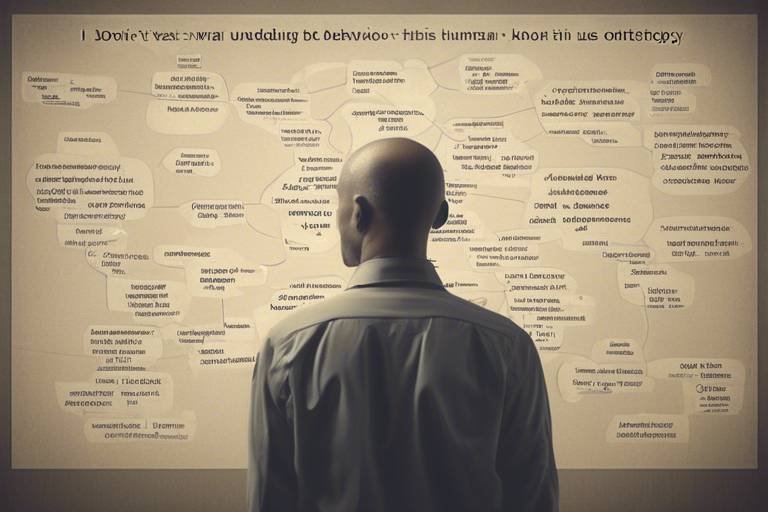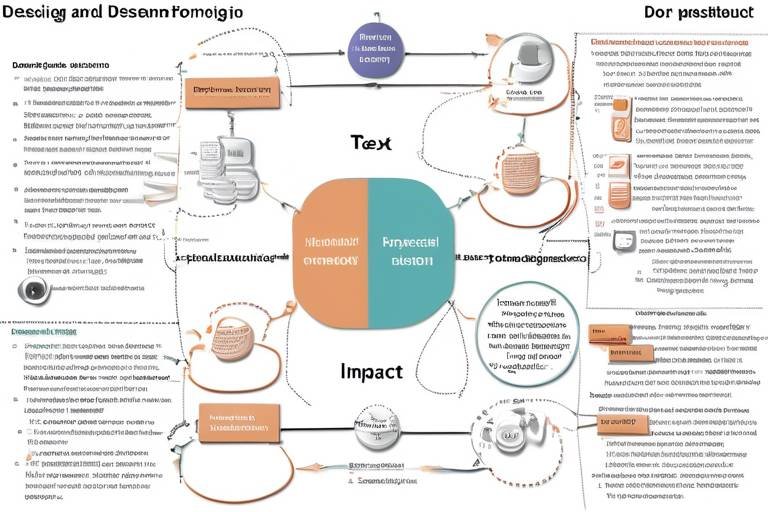The Impact of Ontology on Medical Science
In the rapidly evolving landscape of healthcare, ontology emerges as a pivotal force that shapes the way we understand, organize, and utilize medical knowledge. At its core, ontology in medical science is not just a fancy term; it's a systematic categorization of medical concepts and their interrelationships. Imagine trying to navigate a vast library without a catalog—chaos, right? That's where ontology steps in, providing a structured framework that enhances data organization and interoperability. This foundational understanding is crucial for advancing healthcare technologies and research, ensuring that we can effectively harness the power of data to improve patient care.
As we delve deeper into the impact of ontology on medical science, it becomes evident that its influence extends far beyond mere categorization. Ontologies facilitate the integration of diverse medical data sources, enabling seamless information sharing across platforms. Think of it as a universal translator for medical data, breaking down barriers and allowing healthcare providers to access and utilize information efficiently. This integration is not just a technical necessity; it significantly enhances the quality of patient care and supports evidence-based decision-making in clinical settings.
Moreover, the role of standardized medical terminologies, such as SNOMED CT and LOINC, cannot be overstated. These standards are the backbone of effective communication among healthcare professionals. Ontologies underpin these standards, ensuring consistency and accuracy in medical records and data exchange. By employing ontologies, medical professionals can achieve a common understanding of terms and concepts, leading to better outcomes. But it’s not all smooth sailing; standardization does come with its own set of challenges, including resistance to change and the complexity of medical language. Addressing these issues is vital for effective ontology implementation.
In conclusion, ontology is not just an abstract concept; it is a powerful tool that shapes the future of medical science. By enhancing data integration, standardizing terminologies, and supporting clinical decision-making, ontology plays a crucial role in improving patient outcomes and advancing healthcare research. As we continue to explore its applications, we must also remain vigilant about the challenges it presents, ensuring that we can fully leverage its potential in the ever-changing world of medicine.
- What is ontology in medical science?
Ontology in medical science refers to the systematic categorization of medical concepts and relationships, providing a framework for data organization and interoperability. - How does ontology enhance patient care?
By facilitating data integration and standardizing medical terminologies, ontology improves communication among healthcare providers, which ultimately enhances patient care and supports evidence-based decisions. - What are some challenges associated with medical ontology?
Challenges include resistance to change, the complexity of medical language, and the need for continuous updates to ensure accuracy and relevance. - Why are standardized medical terminologies important?
Standardized terminologies, such as SNOMED CT and LOINC, ensure consistent communication among healthcare professionals, reducing errors and improving patient safety.

Understanding Ontology in Medicine
Ontology in medical science is not just a fancy term tossed around in academic circles; it’s the backbone of how we categorize and understand the vast array of medical knowledge. Imagine trying to navigate a library without a catalog—chaos, right? That’s what medical professionals face without a structured approach to organizing medical concepts and their relationships. Ontology provides this much-needed framework, enabling healthcare providers to effectively manage information and ensure interoperability across various platforms.
At its core, ontology is about defining the types of entities that exist within a specific domain and the relationships between them. In medicine, this means creating a comprehensive map of diseases, symptoms, treatments, and even patient demographics. By establishing clear definitions and relationships, ontology allows for a more coherent understanding of medical data, which is crucial for advancing both research and clinical practices.
For instance, consider the following key components that ontology addresses in medicine:
- Medical Concepts: These include diseases, symptoms, procedures, and medications.
- Relationships: How these concepts interact, such as which symptoms are indicative of certain diseases.
- Hierarchical Structures: Organizing concepts from general to specific, which helps in understanding the broader context of medical knowledge.
By providing a structured approach, ontology enhances the ability to share and integrate data from various sources, making it easier for healthcare providers to access relevant information when they need it the most. This is particularly important in today's data-driven world, where the sheer volume of medical information can be overwhelming. With a well-defined ontology, healthcare professionals can quickly find the information they need without getting lost in a sea of data.
Moreover, ontology plays a pivotal role in the development of advanced healthcare technologies, such as electronic health records (EHRs) and clinical decision support systems (CDSS). These systems rely on standardized ontologies to ensure that data is consistently interpreted and utilized, leading to better patient outcomes. In a nutshell, understanding ontology in medicine is not just an academic exercise; it’s a practical necessity that directly impacts the quality of care patients receive.
As we move forward, the importance of ontology in medical science will only continue to grow. With ongoing advancements in artificial intelligence and machine learning, the ability to leverage ontological frameworks will be crucial in extracting meaningful insights from complex medical data. Thus, embracing ontology is not merely about keeping up with trends; it's about laying the groundwork for a more effective and efficient healthcare system.

The Role of Ontologies in Data Integration
Ontologies are the unsung heroes of data integration in the medical field. Imagine trying to assemble a jigsaw puzzle where all the pieces come from different boxes; that's what healthcare data looks like without ontologies. They provide a structured framework that allows various data sources to communicate effectively, ensuring that information flows seamlessly across different platforms. This is crucial because, in healthcare, timely access to accurate data can mean the difference between life and death.
By employing ontologies, healthcare systems can integrate diverse data types—from electronic health records (EHR) to lab results and imaging studies. This integration not only enhances the quality of patient care but also supports evidence-based decision-making. For instance, when a doctor accesses a patient's medical history, they can see a comprehensive view that includes medications, allergies, and previous diagnoses, all thanks to the underlying ontological structure.
One of the key benefits of using ontologies for data integration is their ability to standardize medical terminology. This standardization eliminates the confusion that arises from different terminologies and abbreviations used by various healthcare providers. For example, the same condition might be referred to as "hypertension" in one system and "high blood pressure" in another. Ontologies reconcile these differences, ensuring that everyone speaks the same language.
However, achieving effective data integration through ontologies is not without its challenges. Below are some common hurdles faced in this process:
- Complexity of Medical Data: Medical data is inherently complex, containing various formats and structures that can complicate integration efforts.
- Resistance to Change: Healthcare professionals may be hesitant to adopt new systems and terminologies, making it difficult to implement ontological frameworks.
- Continuous Updates: Medical knowledge is always evolving, and keeping ontologies up to date is a significant challenge that requires ongoing effort.
Despite these challenges, the potential for improved patient outcomes through effective data integration is immense. By harnessing the power of ontologies, healthcare providers can not only enhance the quality of care but also facilitate research and innovation. For example, integrated data allows researchers to identify trends and correlations that were previously hidden, ultimately leading to breakthroughs in treatment and diagnostics.
In conclusion, ontologies are pivotal in transforming the landscape of data integration in medical science. They bridge the gap between disparate data sources, enabling healthcare professionals to make informed decisions that enhance patient care. As we continue to advance in technology and data management, the role of ontologies will only become more critical in shaping the future of healthcare.
What is an ontology in medical science?
An ontology in medical science is a structured framework that categorizes medical concepts and their relationships, facilitating data organization and interoperability across various healthcare systems.
How do ontologies improve patient care?
Ontologies enhance patient care by enabling seamless data integration from multiple sources, ensuring healthcare providers have access to comprehensive and accurate patient information for informed decision-making.
What are some challenges in implementing ontologies?
Challenges include the complexity of medical data, resistance to change from healthcare professionals, and the need for continuous updates to keep ontologies relevant and accurate.

Standardization of Medical Terminologies
Standardized medical terminologies are the backbone of effective communication in healthcare. They serve as a universal language, ensuring that healthcare professionals can share information without ambiguity. Imagine a world where doctors, nurses, and researchers can seamlessly exchange ideas and data without the fear of misinterpretation. This is the promise of standardized terminologies like SNOMED CT and LOINC. These ontologies not only help in documenting patient information accurately but also enhance the interoperability of different healthcare systems.
The importance of standardization cannot be overstated. When medical terms are standardized, it leads to a myriad of benefits, including improved patient safety and reduced medical errors. For instance, if a physician and a pharmacist use different terminologies for the same medication, it could lead to dangerous situations. By employing a common vocabulary, healthcare professionals can ensure that everyone is on the same page, ultimately leading to better patient outcomes.
However, achieving standardization is not without its hurdles. The complexity of medical language, coupled with the resistance to change among some professionals, poses significant challenges. Moreover, the medical field is ever-evolving, and as new discoveries are made, existing terminologies must be updated to reflect current knowledge. This continuous need for updates can create a daunting task for those involved in developing and maintaining these standards.
In summary, standardized medical terminologies are essential for effective communication and data sharing in healthcare. They help to bridge the gap between different systems and professionals, ensuring that patient care is not compromised. As we move forward, it is crucial to address the challenges of standardization head-on, fostering an environment where ontologies can thrive and enhance the quality of healthcare.
- What are standardized medical terminologies?
Standardized medical terminologies are agreed-upon sets of terms used in healthcare to ensure clear communication among professionals. - Why is standardization important in healthcare?
It reduces misunderstandings, improves patient safety, and enhances the interoperability of healthcare systems. - What are some examples of standardized medical terminologies?
Examples include SNOMED CT, LOINC, and ICD-10, each serving different purposes in medical coding and classification. - What challenges does standardization face?
Challenges include resistance to change, the complexity of medical language, and the need for ongoing updates.

Benefits of Standardization
Standardization in medical terminology is not just a technical requirement; it is a crucial element that enhances the overall quality of healthcare delivery. By establishing a common language among healthcare professionals, standardization fosters clear communication, which is vital for effective patient care. Imagine a world where doctors, nurses, and specialists speak different languages—chaos would ensue, and patient safety would be compromised. Standardization eliminates this risk by ensuring that everyone is on the same page.
One of the most significant benefits of standardization is the improvement in patient safety. When medical terms are uniformly defined and understood, the chances of misinterpretation diminish significantly. For instance, a standardized approach to documenting allergies or medications can prevent potentially life-threatening errors. This uniformity allows healthcare providers to quickly and accurately assess a patient's medical history, leading to better-informed decisions.
Moreover, standardization enhances interoperability among healthcare systems. In today's digital age, patients often receive care from multiple providers and institutions. Without standardized terminologies, sharing patient information can become a cumbersome process, fraught with misunderstandings. However, when ontologies underpin these standards, data can be exchanged seamlessly across different platforms. This interoperability not only streamlines administrative processes but also ensures that critical patient information is readily accessible, ultimately leading to improved outcomes.
Another noteworthy advantage is the facilitation of data analytics and research. With standardized data, healthcare organizations can aggregate information from various sources to identify trends, monitor public health, and conduct meaningful research. For example, researchers can analyze large datasets to discover new correlations between treatments and patient outcomes. This kind of analysis is invaluable for advancing medical knowledge and improving treatment protocols.
In addition to these benefits, standardization also plays a pivotal role in training and education. When medical students and professionals are taught using standardized terminologies, they develop a comprehensive understanding of medical concepts that transcends individual specialties. This common foundation not only enhances their learning experience but also prepares them for collaborative practice in the real world.
Despite the numerous advantages, it is important to acknowledge that the journey toward standardization is not without its challenges. Change often meets resistance, especially in fields as traditional as medicine. However, the long-term benefits of standardization far outweigh the initial hurdles. By committing to this process, healthcare professionals can significantly enhance the quality of care provided to patients.
In conclusion, the benefits of standardization in medical terminology are profound and far-reaching. From improving patient safety and enhancing interoperability to facilitating research and education, standardization is a cornerstone of effective healthcare. By embracing ontologies and standardized terminologies, the medical community can work towards a future where patient care is not only efficient but also safe and effective.
- What is the main purpose of standardization in medicine?
The main purpose of standardization in medicine is to create a common language that enhances communication, reduces errors, and improves patient safety across healthcare settings.
- How do ontologies contribute to standardization?
Ontologies provide a structured framework that categorizes medical concepts and relationships, underpinning standardized terminologies and ensuring consistency in medical records.
- What challenges does standardization face?
Challenges include resistance to change, the complexity of medical language, and the need for continuous updates to keep standards relevant and comprehensive.
- Why is interoperability important in healthcare?
Interoperability is crucial because it allows different healthcare systems to share and access patient information seamlessly, which is vital for coordinated and effective patient care.

Challenges in Standardization
Standardization in medical terminology is not as straightforward as it might seem. While the benefits are clear, the road to achieving uniformity is riddled with obstacles. One of the most significant challenges is the resistance to change among healthcare professionals. Many practitioners have used their own terminologies for years, and the thought of adapting to a standardized system can feel overwhelming. It's like trying to teach an old dog new tricks; the reluctance to shift from familiar practices can hinder progress.
Another major hurdle is the complexity of medical language. Medicine is a field filled with jargon and specialized terms that can vary significantly across different specialties. For instance, a term that is commonplace in cardiology might be completely unfamiliar to a neurologist. This discrepancy complicates the creation of a universal ontology that everyone can agree upon. Imagine trying to build a bridge between two islands with different languages; without a common tongue, communication becomes nearly impossible.
Moreover, there is the need for continuous updates. The medical field is constantly evolving, with new discoveries and technologies emerging at a rapid pace. Keeping ontologies up to date with the latest knowledge is a daunting task. For example, consider the introduction of new diseases or treatments; if the ontology isn't updated promptly, it risks becoming obsolete. This dynamic environment requires a robust system for ongoing revisions, which can be resource-intensive and time-consuming.
To summarize, the challenges in standardization can be categorized into the following key areas:
- Resistance to Change: Many healthcare professionals are hesitant to adopt new terminologies.
- Complexity of Medical Language: Diverse terminologies across specialties complicate standardization efforts.
- Need for Continuous Updates: Rapid advancements in medicine necessitate regular updates to ontologies.
Addressing these challenges is vital for the effective implementation of ontologies in medical practice. It requires collaboration, education, and a willingness to adapt. Only through collective effort can the healthcare industry overcome these barriers and fully realize the potential of standardized medical terminologies.
1. What is ontology in medical science?
Ontology in medical science refers to the systematic categorization of medical concepts and their relationships, providing a structured framework for organizing and sharing data.
2. Why is standardization important in healthcare?
Standardization ensures consistency and accuracy in medical records, enhances communication among healthcare professionals, and ultimately improves patient safety and care outcomes.
3. What are some common challenges in achieving standardization?
Challenges include resistance to change, the complexity of medical language, and the need for ongoing updates to reflect new medical knowledge.
4. How do ontologies support clinical decision-making?
Ontologies enhance clinical decision support systems by structuring knowledge, which improves the accuracy and relevance of recommendations made to healthcare providers.
5. Can ontologies facilitate interdisciplinary collaboration?
Yes, ontologies provide a common language that allows professionals from various disciplines to collaborate effectively on complex health issues.

Enhancing Clinical Decision Support Systems
In today's fast-paced healthcare environment, the need for accurate and timely information is more critical than ever. Clinical Decision Support Systems (CDSS) are designed to assist healthcare providers in making informed decisions by providing relevant patient data, evidence-based guidelines, and expert recommendations. But how do ontologies play a pivotal role in enhancing these systems? Well, it all starts with the organization of knowledge.
Ontologies provide a structured framework that categorizes medical concepts and their relationships, making it easier for CDSS to interpret complex data. Imagine trying to find a specific book in a vast library without a catalog—overwhelming, right? Ontologies act as that catalog, ensuring that healthcare providers can quickly access the information they need. By structuring knowledge, they help improve the accuracy and relevance of recommendations, which can significantly impact patient outcomes.
One of the standout features of ontologies in CDSS is their ability to integrate diverse data sources. For instance, a CDSS can pull information from electronic health records (EHRs), laboratory results, and even patient history to create a comprehensive view of a patient's health. This integration allows for a more holistic approach to patient care, ensuring that recommendations consider all relevant factors. In a sense, it's like having a team of specialists working together to provide the best possible care for a patient.
Moreover, ontologies facilitate the incorporation of clinical guidelines and protocols into CDSS. By utilizing standardized medical terminologies, such as SNOMED CT and LOINC, these systems can deliver consistent and reliable recommendations. This standardization is vital for maintaining accuracy and ensuring that healthcare providers are on the same page when it comes to patient care.
However, enhancing CDSS with ontologies is not without its challenges. The complexity of medical language and the need for continuous updates can pose significant hurdles. For instance, medical knowledge is constantly evolving, and so too must the ontologies that underpin these systems. If an ontology is not regularly updated, it risks becoming outdated, which can lead to incorrect recommendations and, ultimately, compromised patient safety.
To address these challenges, it's crucial for healthcare organizations to invest in training and resources that promote the effective use of ontologies within CDSS. This includes educating healthcare providers on the importance of these systems and how to interpret the recommendations they provide. By fostering a culture of collaboration and continuous learning, organizations can harness the full potential of ontologies to enhance clinical decision-making.
In summary, ontologies are not just a technical component of Clinical Decision Support Systems; they are the backbone that supports informed decision-making in healthcare. By organizing medical knowledge, integrating diverse data sources, and ensuring standardized communication, ontologies significantly enhance the quality of care provided to patients. As we continue to advance in the field of medicine, the role of ontologies will undoubtedly grow, leading to even more sophisticated and effective CDSS in the future.
- What is a Clinical Decision Support System (CDSS)?
A CDSS is a health information technology system that provides healthcare professionals with knowledge and patient-specific information to enhance decision-making in patient care. - How do ontologies improve CDSS?
Ontologies improve CDSS by providing a structured framework for organizing medical knowledge, ensuring accurate and relevant recommendations based on integrated data sources. - What are some challenges in implementing ontologies in CDSS?
Challenges include the complexity of medical language, the need for continuous updates, and ensuring user acceptance among healthcare providers.

Ontology in Biomedical Research
In the ever-evolving landscape of biomedical research, the role of ontology cannot be overstated. It serves as a backbone, supporting the organization and analysis of vast amounts of data generated from various studies and clinical trials. Imagine trying to navigate a massive library filled with millions of books without a catalog system; that’s what biomedical research would be like without ontologies. By providing a structured framework, ontologies enable researchers to identify patterns, relationships, and insights that are crucial for driving innovation in treatment and diagnostics.
One of the most significant advantages of employing ontologies in biomedical research is their ability to facilitate the integration of heterogeneous data sources. Researchers often work with data from different disciplines, ranging from genomics to epidemiology. Ontologies create a common language that bridges these diverse fields, allowing for seamless data sharing and collaboration. For instance, when researchers from genetics and pharmacology collaborate, ontologies help them align their terminologies and concepts, making it easier to understand each other’s findings and insights.
Furthermore, ontologies play a pivotal role in enhancing data analysis. With the explosion of big data in healthcare, traditional methods of data analysis are becoming increasingly inadequate. Ontologies allow for more sophisticated analytical techniques, such as machine learning and natural language processing, to be applied to biomedical data. This leads to more accurate predictions and a deeper understanding of complex biological processes. For example, ontologies can help in predicting disease progression by correlating genetic data with clinical outcomes, ultimately leading to more personalized treatment strategies.
However, developing effective biomedical ontologies is not without its challenges. One major hurdle is ensuring comprehensive coverage of the vast array of medical concepts. As the field of medicine continues to grow, so too do the terminologies and relationships that need to be captured. Additionally, maintaining updates to reflect new discoveries and changes in medical knowledge is crucial. If an ontology becomes outdated, it can lead to misinterpretations and errors in research findings. Lastly, achieving user acceptance is vital; researchers must find value in using these ontologies for them to be successfully integrated into their workflows.
To illustrate the impact of ontologies in biomedical research, consider the following table that highlights some key areas where ontologies have made a difference:
| Area of Impact | Description |
|---|---|
| Data Integration | Facilitates seamless sharing of data across various medical disciplines. |
| Pattern Recognition | Enables identification of trends and correlations in large datasets. |
| Collaboration | Promotes interdisciplinary research by providing a common vocabulary. |
| Enhanced Analysis | Supports advanced analytical techniques for better insights. |
As we look to the future, the ongoing development and refinement of ontologies in biomedical research will be crucial. They will not only streamline research processes but also enhance the overall quality of healthcare outcomes. In a world where data is king, ontologies will continue to be the unsung heroes, quietly but powerfully shaping the future of medical science.
- What is ontology in biomedical research? Ontology in biomedical research refers to the systematic categorization of medical concepts and their relationships, which helps in organizing and analyzing data.
- How do ontologies enhance data integration? Ontologies provide a common language that allows researchers to share and understand data from diverse sources, facilitating collaboration.
- What challenges do ontologies face in biomedical research? Key challenges include ensuring comprehensive coverage, maintaining updates, and achieving user acceptance.
- Why are ontologies important for clinical decision-making? They enhance the accuracy and relevance of recommendations made by clinical decision support systems, ultimately improving patient care.

Facilitating Interdisciplinary Collaboration
In the ever-evolving landscape of healthcare, the complexity of medical challenges often requires a collaborative approach that transcends traditional disciplinary boundaries. Ontology serves as a bridge, connecting various fields of expertise and fostering a shared understanding that is essential for effective problem-solving. Imagine a group of experts from diverse backgrounds—doctors, researchers, data analysts, and even software engineers—coming together to tackle a pressing health issue. Without a common language and framework, their efforts could easily become fragmented, leading to miscommunication and inefficiencies. This is where ontologies shine, providing a structured vocabulary that everyone can understand.
By establishing a common ground, ontologies enable seamless communication among professionals from different specializations. For instance, consider a scenario where a team is working on a new treatment for a rare disease. The medical team needs to collaborate with geneticists to understand the underlying biological mechanisms while also involving data scientists to analyze patient data effectively. Ontologies facilitate this interdisciplinary collaboration by defining the relationships between various concepts, such as symptoms, genetic markers, and treatment protocols.
Moreover, ontologies also enhance the ability to share and reuse data across disciplines. When researchers use standardized ontological frameworks, they can easily integrate findings from various studies, leading to more comprehensive insights and innovations. This is particularly crucial in fields like biomedical research, where the volume of data generated is staggering. With ontologies, researchers can:
- Identify relevant datasets across disciplines
- Analyze data with a unified approach
- Facilitate the discovery of new patterns and relationships
The implications of this interdisciplinary approach are profound. By breaking down silos, ontologies not only enhance collaboration but also drive innovation in treatment and diagnostics. When experts from different fields work together, they can leverage their unique perspectives and skills, ultimately leading to more effective solutions. The future of healthcare relies on such collaborative efforts, and ontologies are at the forefront of making this possible.
In conclusion, the role of ontologies in facilitating interdisciplinary collaboration cannot be overstated. They provide the necessary structure and common language that allow diverse professionals to work together efficiently. As we continue to face complex health challenges, embracing ontologies will be crucial in harnessing the collective expertise of the medical and scientific communities.
- What is ontology in medical science?
Ontology in medical science refers to the systematic categorization of medical concepts and relationships, providing a framework for data organization and interoperability. - How do ontologies improve interdisciplinary collaboration?
Ontologies create a common language that allows professionals from different fields to communicate effectively, share data, and work together on complex health issues. - What are some examples of standardized medical terminologies?
Examples include SNOMED CT and LOINC, which are essential for ensuring consistency and accuracy in medical records and data exchange. - What challenges do ontologies face in biomedical research?
Challenges include ensuring comprehensive coverage, maintaining updates, and achieving user acceptance.

Challenges in Biomedical Ontology Development
The development of biomedical ontologies is not without its hurdles. One of the most significant challenges is ensuring comprehensive coverage of medical concepts. With the rapid evolution of medical knowledge, new terms and relationships are constantly emerging. This creates a daunting task for ontology developers to keep up with the ever-expanding lexicon of the medical field. Imagine trying to build a library of knowledge where new books are released every day; it can feel overwhelming!
Another critical challenge is the need for continuous updates. Just like software requires regular patches and updates, ontologies must be revised to reflect the latest research findings and clinical practices. This means that developers must not only create the initial structure but also implement a robust system for ongoing maintenance. Failure to do so can lead to outdated information, which can have serious implications for patient care and research outcomes.
Moreover, achieving user acceptance is a significant hurdle. Healthcare professionals and researchers often have their own preferred terminologies and frameworks. Convincing them to adopt a standardized ontology can be likened to asking someone to switch their favorite recipe for a family dish—it's not just about the food; it's about tradition and familiarity. Resistance to change can stall the implementation of ontologies, making it crucial for developers to engage stakeholders early in the process to foster buy-in.
Additionally, the complexity of medical language poses another barrier. Medical terminology is often laden with jargon that can be confusing even to seasoned professionals. This complexity can make it challenging to create ontologies that are both comprehensive and user-friendly. To address this, developers need to invest time in creating intuitive interfaces and providing adequate training for users, which can stretch resources thin.
Finally, the issue of interoperability cannot be overlooked. Different healthcare systems and institutions often use varying standards and formats for data. Ensuring that ontologies can work seamlessly across these diverse systems requires significant effort and collaboration. It’s like trying to fit pieces from different puzzles together—only by finding a common ground can we hope to create a cohesive picture of patient data.
In summary, while the development of biomedical ontologies holds immense potential for improving healthcare, it is fraught with challenges. Overcoming these obstacles requires a concerted effort from developers, healthcare professionals, and researchers alike. By fostering collaboration and maintaining a focus on user needs, we can pave the way for more effective and widely accepted biomedical ontologies.
- What is biomedical ontology? Biomedical ontology is a structured framework for organizing medical knowledge, including concepts and relationships, to facilitate data sharing and research.
- Why is standardization important in medical terminology? Standardization ensures consistency and accuracy in medical records, improving communication among healthcare professionals and enhancing patient safety.
- What challenges do developers face when creating ontologies? Developers face challenges such as ensuring comprehensive coverage, maintaining updates, achieving user acceptance, and addressing the complexity of medical language.
- How do ontologies support clinical decision-making? Ontologies enhance clinical decision support systems by structuring knowledge, which leads to more accurate and relevant recommendations for healthcare providers.
Frequently Asked Questions
- What is ontology in medical science?
Ontology in medical science refers to the systematic categorization of medical concepts and their relationships. It's like creating a detailed map of the medical landscape, helping researchers and practitioners understand how different terms and concepts connect to one another.
- How do ontologies improve data integration in healthcare?
Ontologies facilitate the integration of diverse medical data sources by providing a common framework for sharing information. Think of it as a universal translator for medical data, ensuring that everyone—from doctors to researchers—can communicate effectively and access the same information seamlessly.
- What are standardized medical terminologies?
Standardized medical terminologies, such as SNOMED CT and LOINC, are essential for effective communication in healthcare. They serve as a shared language that ensures consistency and accuracy in medical records, much like a dictionary that everyone in the field agrees to use.
- What are the benefits of standardization in medical terminology?
Standardization enhances patient safety, reduces errors, and improves interoperability among healthcare systems. By having a common understanding of terms, medical professionals can collaborate more effectively, leading to better patient outcomes and streamlined processes.
- What challenges does standardization face?
Standardization faces challenges such as resistance to change among professionals, the complexity of medical language, and the need for constant updates. Overcoming these hurdles is crucial for the effective implementation of ontologies in healthcare.
- How do ontologies enhance clinical decision support systems?
Ontologies enhance clinical decision support systems (CDSS) by structuring knowledge in a way that improves the accuracy and relevance of recommendations. This means that healthcare providers get better insights, enabling them to make more informed decisions about patient care.
- What role do ontologies play in biomedical research?
In biomedical research, ontologies help organize and analyze vast amounts of data, allowing researchers to identify patterns and relationships. This is crucial for driving innovation in treatments and diagnostics, much like having a powerful search engine for complex medical data.
- How do ontologies facilitate interdisciplinary collaboration?
Ontologies promote collaboration among various disciplines by providing a common language that everyone can understand. This is essential for tackling complex health issues that require insights from multiple fields, ensuring that experts can work together efficiently.
- What challenges are faced in developing biomedical ontologies?
Developing effective biomedical ontologies comes with challenges such as ensuring comprehensive coverage, maintaining updates, and achieving user acceptance. Addressing these challenges is vital for maximizing the impact of ontologies in research and clinical settings.


















